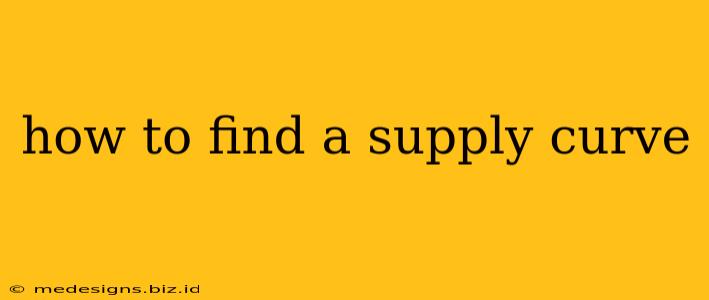Understanding the supply curve is crucial for anyone involved in economics, business, or market analysis. This comprehensive guide will walk you through different methods for finding and interpreting supply curves, whether you're dealing with theoretical models or real-world market data.
What is a Supply Curve?
Before we dive into how to find one, let's clarify what a supply curve represents. A supply curve is a graphical representation of the relationship between the price of a good or service and the quantity supplied by producers at various price points, ceteris paribus (all other factors remaining constant). It typically slopes upwards, indicating that as the price increases, the quantity supplied also increases.
Methods for Finding a Supply Curve
There are several ways to determine the supply curve, depending on the available information and the level of detail required:
1. Using Market Data: The Empirical Approach
This is the most common method for determining a supply curve in the real world. It involves collecting data on the quantity of a good or service supplied at different price points over a given period. This data can often be gathered from:
- Government statistics: Many governments collect and publish data on production and sales of various goods and services.
- Industry reports: Trade associations and market research firms often compile data on supply and demand in specific industries.
- Company records: Businesses that track their sales data at various price points can use this information to construct a supply curve for their specific product.
Analyzing the Data: Once you've collected your data, you can use statistical methods like regression analysis to estimate the relationship between price and quantity supplied. The resulting equation will give you the mathematical representation of your supply curve. Remember to consider potential outliers and ensure your data is accurate and reliable.
2. Using the Firm's Cost Structure: The Theoretical Approach
For a theoretical supply curve, particularly for a single firm, you can utilize the firm's cost structure. This approach focuses on the relationship between the firm's marginal cost (MC) and the market price (P).
- Marginal Cost (MC): This represents the additional cost of producing one more unit of the good.
- Market Price (P): The price at which the good is sold in the market.
A firm will typically produce at the level where its MC equals the market price (MC = P). By calculating the MC at different production levels and plotting it against the quantity, you can derive the firm's supply curve. This is the short-run supply curve. In the long run, factors such as changes in capital and technology also affect supply.
3. Using Qualitative Factors: Expert Opinion and Surveys
In some cases, particularly for newer products or markets with limited data, you may need to rely on expert opinion and surveys to estimate a supply curve. This approach involves gathering information from industry experts, producers, and consumers to assess the likely response of supply to changes in price. While less precise than quantitative methods, this can provide valuable insights, particularly when supplemented with other data sources.
Interpreting the Supply Curve
Once you have your supply curve, you can use it to predict how changes in price will affect the quantity supplied. A steeper supply curve indicates that the quantity supplied is less responsive to price changes (inelastic supply), while a flatter curve indicates a more responsive quantity supplied (elastic supply).
Factors Affecting the Supply Curve
Remember that the supply curve is drawn under the assumption of ceteris paribus. However, several factors can shift the entire supply curve:
- Changes in input prices: Increased input costs (e.g., raw materials, labor) shift the supply curve to the left (decrease in supply).
- Technological advancements: Technological improvements shift the supply curve to the right (increase in supply).
- Government regulations: Taxes, subsidies, and regulations can also shift the supply curve.
- Producer expectations: Future price expectations can influence current supply decisions.
- Number of sellers: An increase in the number of sellers shifts the supply curve to the right.
By understanding how to find and interpret supply curves, you can gain valuable insights into market dynamics and make more informed decisions in various contexts. Remember to always consider the limitations of your data and the assumptions underlying your analysis.
